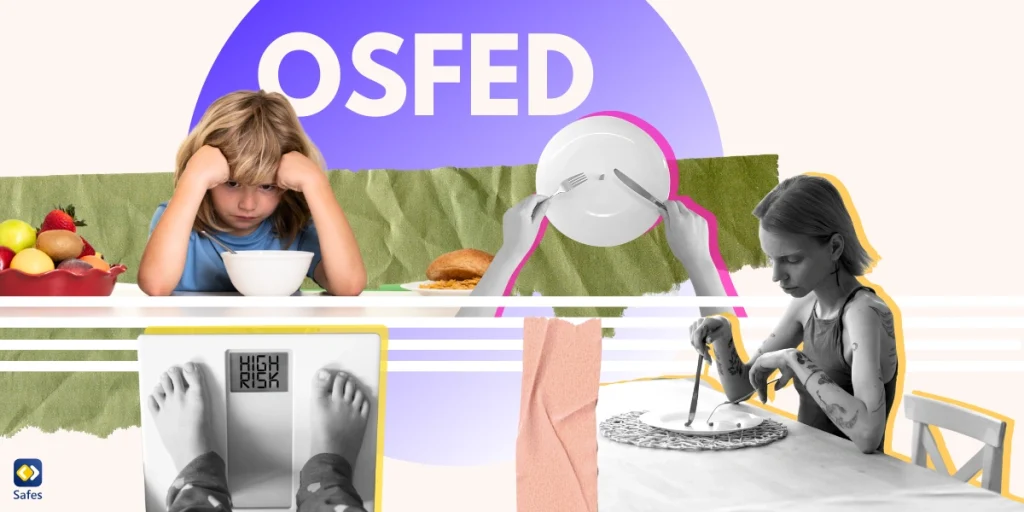Understanding eating disorders and being committed to treating them are necessary for fostering the well-being of our loved ones, especially when it comes to the less well-known category of Other Specified Feeding or Eating Disorder (OSFED). Parents must educate themselves about OSFED and its complexity in order to provide our children with the support they need. According to BetterHealth, “OSFED is one of the most common eating disorders in Australia.” In this blog post, we define and diagnose OSFED while emphasizing the challenges it poses for both people and families. Our research into this intricate ailment aims to provide parents with information on how they could play a critical role in their child’s recovery.
Download and Start Your Free Trial of the Safes Parental Control App
What Is OSFED Eating Disorder?
The acronym OSFED refers to “Other Specified Feeding or Eating Disorder.” The Diagnostic and Statistical Manual of Mental illnesses (DSM-5) is a standard categorization of mental illnesses used by mental health professionals. OSFED is one category within this manual. It can also go by the name of UFED eating disorder though OSFED is more common.
When a person’s symptoms do not exactly match those of binge-eating disorder, bulimia nervosa, anorexia nervosa, or avoidant/restrictive food intake disorder (ARFID), but they nonetheless cause them great discomfort and impairment because of their eating habits, OSFED is utilized. A variety of eating patterns and behaviors that might not easily fit into the other listed categories are included in OSFED.
How Is OSFED Diagnosed?
Mental health practitioners and experts are among the healthcare providers that generally diagnose OSFED (other specified feeding or eating disorder). The Diagnostic and Statistical guidebook of Mental Disorders, Fifth Edition (DSM-5) is a commonly used guidebook for categorizing mental health illnesses, and it contains the diagnostic criteria for OSFED.
An individual must demonstrate disordered eating behaviors that significantly disrupt their life and do not fit the criteria for other specific eating disorders, such as binge-eating disorder, bulimia nervosa, anorexia nervosa, or avoidant/restrictive food intake disorder (ARFID), in order to be diagnosed with OSFED. The precise requirements for OSFED might involve a range of symptoms, like:
- Atypical or limited food choices: A restricted range of food intake that does not meet criteria for anorexia nervosa, but is still significant enough to cause impairment.
- Episodes of binge eating: Consuming an amount of food that is larger than what most people would eat in a discrete period, but occurring less frequently or with less regularity than in binge-eating disorder.
- Purging behaviors: Engaging in behaviors to prevent weight gain, such as vomiting or excessive exercise, but occurring less frequently or with less regularity than in bulimia nervosa.
- Chewing and spitting out food: Persistent chewing of food followed by spitting it out, without swallowing.
- Other feeding or eating behaviors: Any other feeding or eating behaviors such as food touching phobia that cause clinically significant distress or impairment.

What Can Parents Do About OSFED?
If a parent suspects or knows that their child is dealing with OSFED (Other Specified Feeding or Eating Disorder), taking appropriate steps is crucial. Here are some suggestions for what parents can do:
-
Seek Professional Help
Schedule an appointment with a healthcare professional who specializes in eating and food anxiety disorders. This could be a psychologist, psychiatrist, or a medical doctor with expertise in this area.
-
Create an Open and Supportive Environment
Encourage open communication with your child about their feelings, concerns, and experiences. Avoid judgment or blame. Instead, express your support and willingness to help.
-
Educate Yourself
Learn about OSFED, its symptoms, and its impact. Understanding the disorder and how unhealthy relationships with food work, will help you support your child better. Understanding how other eating disorders work such as childhood obesity can also help.
-
Collaborate with Healthcare Professionals
Work closely with the healthcare team to develop a comprehensive treatment plan. This may involve mental health professionals, nutritionists, and medical doctors.
-
Encourage Healthy Habits
Promote a positive approach to nutrition and a healthy relationship with food. Encourage regular and balanced meals. However, avoid making food a source of stress or conflict.
-
Monitor and Support Progress
Keep track of your child’s progress in treatment and provide ongoing support. Be patient, as recovery from eating disorders can be a gradual process.
-
Involve the Family
Engage the entire family in the recovery process of anxiety and eating disorders. This might include family therapy sessions to address relational dynamics and support.
-
Address Co-occurring Issues
Be aware of any co-occurring mental health issues and ensure they are addressed as part of the treatment plan.
-
Encourage Self-Esteem and Body Positivity
Promote a positive body image and self-esteem. Encourage activities that foster self-confidence and self-expression. Social media can have a negative effect on self-esteem and can even play a part in eating disorder statistics.
-
Stay Informed and Connected
Stay informed about your child’s treatment plan and attend therapy sessions when appropriate. Connect with support groups or other parents who have experienced similar challenges.
Conclusion
Collaboration between parents, medical experts, and those with OSFED is necessary to navigate the disorder’s intricacies. Parents may have a big effect by identifying the symptoms, comprehending the diagnosis process, and actively taking part in the treatment and recovery process. Crucial actions include promoting a healthy relationship with food, encouraging open communication, and creating a supportive atmosphere. Parents need to develop resilience, awareness, and connection along this journey in order to provide their child the unwavering support that is vital to their wellness. We can collaborate to overcome the challenges posed by OSFED and build a better, more promising future for our family if we have compassion and knowledge.
You can use Safes, our parental control app, to manage your child’s screen time using social media and mitigate the negative effects. You can also use it for positive and negative reinforcement helping to balance your child’s digital life as well as their physical one. Safes is available for download on iOS, Android, Windows, and MacOS. Sign up for a free trial of Safes and access comprehensive resources and support for understanding and managing OSFED.
Your Child’s Online Safety Starts Here
Every parent today needs a solution to manage screen time and keep their child safe online.
Without the right tools, digital risks and excessive screen time can impact children's well-being. Safes helps parents set healthy boundaries, monitor activity, and protect kids from online dangers—all with an easy-to-use app.
Take control of your child’s digital world. Learn more about Safes or download the app to start your free trial today!




